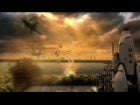Tungsten Rods From Space
Mr. de Plater also showed off three multiplayer modes, Assault, Raid and Seige. Assault is a pretty straightforward versus mode, so we skipped to Raid, which focuses on EndWar's structure interactions. The idea in Raid is to destroy or otherwise sabotage your enemy's buildings, and for that you will want to bring in an engineer or two to really muck things up for the other side. A special attack called Crash comes in handy for this mode, because Crash is a form of cyber attack which destroys the uplinks securing structures to their commanders, rendering them useless.
In Siege, a defender is tasked with holding critical points against an attacker for a set amount of time. When time begins to run short, reinforcements become available to the defender, providing a last-ditch push right when it is needed most.
For all three modes, special faction-specific attacks are made available to whomever is losing in order to keep things interesting right up until the climax of each battle. These special attacks are designed to be devastating weapons of last resort, and as such, come with impressive visuals. Russia can launch literally face-melting mini-nuclear strikes from artillery vehicles, the Euros have an orbital laser lashed to a space station that can burn a hole straight through the Earth's crust, and the best weapon of all resides in the arsenal of the United States.
For the U.S., mere lasers or nukes simply won't cut it. Here in the U.S. of A., we do things big; we eat beef and wrangle horses like cowboys. So, when it comes time to drop hell on an enemy unlucky enough to draw our ultimate ire, we don't shoot beams of coherent light from space, we drop the equivalent of school buses packed with uranium on our target... from space. The U.S. can drop giant tungsten rods from space onto enemies below, and the result is truly spectacular.
These ultimate attacks have something of an ulterior motive, however. They are part of Ubisoft Shanghai's effort to keep people playing EndWar right up until the end of a battle. Essentially, the idea is to keep things competitive throughout the entire game. Mr. de Plater elaborated, "What we noticed in many RTSes is that you'd get to a point in most games where someone was just getting steamrolled and both sides would have to wait while the last remnants were crushed. We didn't want that to happen with EndWar, so we've put features in to keep things interesting for the entire battle." As another bonus, de Plater was quick to point out that players earn experience points towards persistent rewards even if they lose, so simply pulling the plug early on a battle that isn't going your way is really just cheating yourself out of some free experience points.
Push to Talk, Talk to Play
We'd had some readers ask whether or not accents would be trouble for EndWar's speech recognition software, but de Plater was quick to dismiss this as a non-issue. He said, "honestly, the speech recognition that we're using is impressive, so the trouble that we've had is not so much recognizing accents, but rather eliminating errors due to background noise and finalizing the vocabulary for commands." While we noted some difficulty in EndWar's ability to recognize commands in the incredibly noisy event center, the game did surprisingly well given the din we were surrounded by. Still, EndWar can be controlled without voice command as well, and according to de Plater, "well, the most advanced testers have actually been using a combination of both voice and d-pad commands."
Coming in October, Tom Clancy's EndWar is still looking every bit as promising as it has in our previous previews... and maybe a little more.






